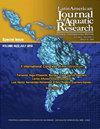智利南部养殖鲑鱼逃逸原因分析
IF 0.8
4区 农林科学
Q3 FISHERIES
Latin American Journal of Aquatic Research
Pub Date : 2023-07-02
DOI:10.3856/vol51-issue3-fulltext-3005
引用次数: 0
摘要
逃逸的鲑鱼被认为是对水生环境最严重的威胁之一。2004年至2021年,智利报告了109起逃逸事件,约有853万鲑鱼逃逸。其中大西洋鲑(Salmo salar) 573万条(67.2%),银鲑(Oncorhynchus kisutch) 83万条(9.8%),虹鳟(O. mykiss) 196万条(23.0%)。据估计,70.1%的逃逸鲑鱼发生在洛斯拉各斯地区,23%发生在ayssamin地区,4.6%发生在麦哲伦地区。总共有80.5%的泄漏来自海水设施,而淡水设施则占19.5%。在2004-2021年期间,海水中记录的鲑鱼逃逸率最高,2013年为捕捞鲑鱼的1.71%。2015年至2021年,约39.5%的逃跑是由于网笼破裂,主要是由于恶劣的气候条件。智利当局于2020年引入的额外法规有助于最大限度地减少养殖鲑鱼的逃逸。因此,2021年仅报告了一起逃跑事件,相当于2004-2021年记录的逃跑总数的3.85%。本文章由计算机程序翻译,如有差异,请以英文原文为准。
Causal analysis of escapement of farmed salmonids in southern Chile
Escaped salmonids are considered among the most serious threats to the aquatic environment. One hundred and nine escape incidents were reported in Chile from 2004-2021, representing some 8.53 million escaped salmonids. Of this total, 5.73 million were Atlantic salmon Salmo salar (67.2%), 0.83 million coho salmon Oncorhynchus kisutch (9.8%), and 1.96 million were rainbow trout O. mykiss (23.0%). It is estimated that 70.1% of the escaped salmonids were recorded in the Los Lagos Region, 23% in the Aysén Region, and 4.6% in the Magallanes Region. In total, 80.5% of the escapes were recorded from seawater facilities, while freshwater units accounted for 19.5%. The highest percentage of escaped salmon recorded in seawater over 2004-2021 was 1.71% of harvested salmonids in 2013. Some 39.5% of the escapes in 2015-2021 were attributed to rupturing of net cages, mainly due to adverse climatic conditions. The additional regulations introduced in 2020 by the Chilean authority, has helped to minimize the escape of farmed salmonids. As a consequence, just one escape event was reported in 2021, corresponding to 3.85% of the total number of escapees recorded from 2004-2021.
求助全文
通过发布文献求助,成功后即可免费获取论文全文。
去求助
来源期刊

Latin American Journal of Aquatic Research
FISHERIES-MARINE & FRESHWATER BIOLOGY
CiteScore
1.70
自引率
10.00%
发文量
44
审稿时长
4-8 weeks
期刊介绍:
Latin American Journal of Aquatic Research- LAJAR is the continuation of the journal Investigaciones Marinas (1970-2007) and is published since 2008 by the Escuela de Ciencias del Mar, Facultad de Ciencias del Mar y Geografía of the Pontificia Universidad Católica de Valparaíso. LAJAR is an “Open Access” journal that publishes in English language, original research articles, reviews and short communications on aquatic science, which contain the results of research conducted in aquaculture or in oceanic and coastal marine waters of Latin America.
The following topics are considered: Physical Oceanography, Chemical Oceanography, Marine Biogeochemistry, Marine Pollution and Toxicology, Marine Geology and Geophysics, Biological Oceanography, Fisheries and Aquaculture.
 求助内容:
求助内容: 应助结果提醒方式:
应助结果提醒方式:


